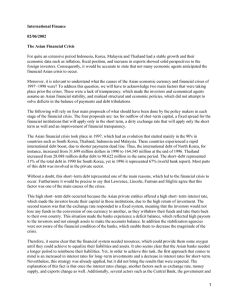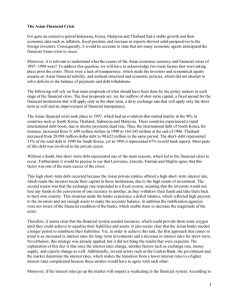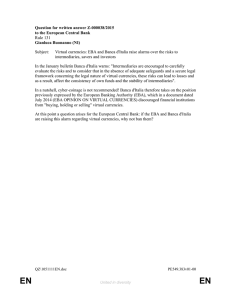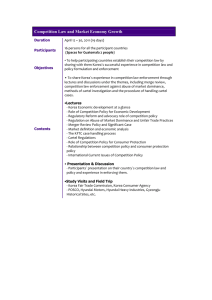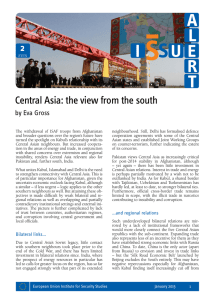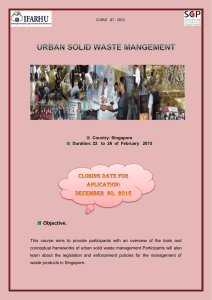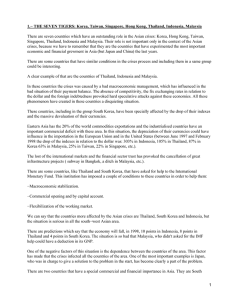Impact of the Financial Crisis on the East Asian Economy
Anuncio
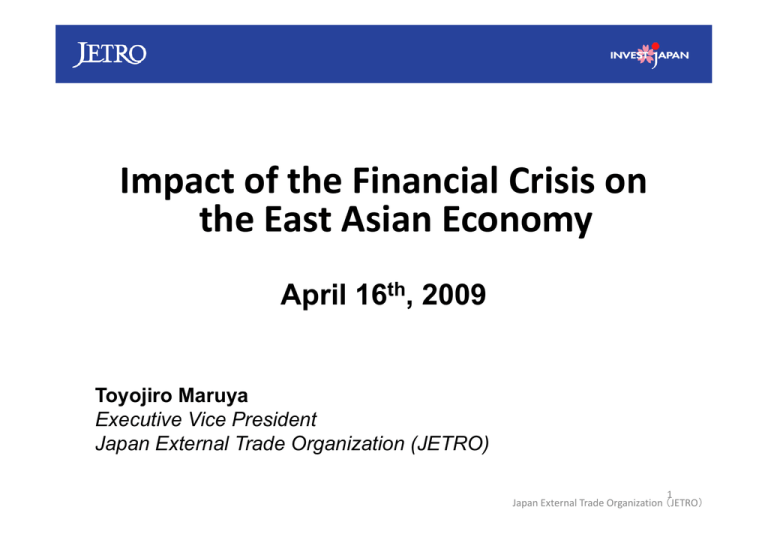
Impact of the Financial Crisis on the East Asian Economy April 16th, 2009 Toyojiro Maruya Executive Vice President Japan External Trade Organization (JETRO) 1 Japan External Trade Organization (JETRO) Topics I. Impact on East Asian Currencies and Finance II. Impact on East Asia’s Macro‐economy III. Expanding Japan‐Chile Relationship Copyright (C) 2009 JETRO. All rights reserved. 2 Japan External Trade Organization (JETRO) I. Impact on East Asian Currencies and Finance Stock Markets in Drastic Correction Phase ・Markets fell by 20% year‐on‐year in Japan and emerging Asian countries -East Asia may have hit bottom in first quarter of 2009 Fig.1 Stock Price Fluctuation in Major Countries / Regions World G7 US Japan Euro area UK Asia* Europe* Latin America* Jan‐ Mar* *emerging countries *Note: as of March 12, 2009 Source: prepared using data from Morgan Stanley Capital International and Thomson Reuters Copyright (C) 2009 JETRO. All rights reserved. 3 Japan External Trade Organization (JETRO) I. Impact on East Asian Currencies and Finance Growing Divergence of East Asian Currencies •Significant differences and acute fluctuation: appreciating Japanese yen and depreciating Korean won •Stable movement: dollar‐pegged Chinese yuan Fig. 2 Fluctuation Rates of East Asian Currencies Against the Dollar 30 China Japan China South Korea India Singapore Thailand Malaysia Indonesia Philippines Vietnam 20 Japan 10 0 -10 -20 S. Korea -30 U.S.$/Asian Currencies -40 -50 Jan-08 Mar-08 May-08 Copyright (C) 2009 JETRO. All rights reserved. Jul-08 Sep-08 Nov-08 Jan-09 Source: http://fx.sauder.ubc.ca/data.html Mar-09 4 Japan External Trade Organization (JETRO) I. Impact on East Asian Currencies and Finance Measures that helped East Asia avoid another currency crisis • Singapore’s Monetary Authority concluded a currency swap agreement with the U.S. Federal Reserve. (October 30, 2008) • Japan, China and South Korea agreed on currency swaps, which helped stabilize the Korean won. (December 12, 2008) • Asian countries agreed on the need to strengthen the Chiang Mai Initiative (CMI) and recapitalize the Asian Development Bank (ADB). Copyright (C) 2009 JETRO. All rights reserved. 5 Japan External Trade Organization (JETRO) I. Impact on East Asian Currencies and Finance Surplus Foreign Reserves Helped Avoid Currency Crisis ・Following the 1997 Asian financial crisis, Asian countries considerably increased their foreign currency reserves, thereby helping to avoid another currency crisis in the region Fig. 3 Increasing Foreign Reserves in Asian Countries Western Western Hemisphere Hemisphere (Latin America) 100% 90% Middle East 80% Dev. Ctys Europe Dev. Ctys: Europe (Central and 70% Eastern Europe) Asia 60% 50% Africa 40% Industrial Countries 30% 20% 10% Copyright (C) 2009 JETRO. All rights reserved. Source: IMF “International Financial Statistics” 2007 2006 2005 2004 2003 2002 2001 2000 1999 1998 1997 1996 1995 1994 1993 1992 1991 1990 0% 6 Japan External Trade Organization (JETRO) I. Impact on East Asian Currencies and Finance Stable Asian Monetary Unit (AMU) Against Dollar and Euro ・As a production base for world markets, Asian economies depend on a stable AMU exchange rate against the dollar and euro to achieve growth and boost competitiveness Fig. 4 Fluctuations of AMU Against Dollar and Euro 1.2 1.0 0.8 0.6 0.4 U.S.$-euro/AMU U.S.$/AMU 0.2 euro/AMU 0.0 Note: AMU(Asian Monetary Unit): Weighted average of Asian currencies (13 countries: 10 ASEAN countries + Japan, China and South Korea) Source: http://www.rieti.go.jp/users/amu/index.html Copyright (C) 2009 JETRO. All rights reserved. 7 Japan External Trade Organization (JETRO) I. Impact on East Asian Currencies and Finance Polarizing of Asian Currencies ・ Although the AMU has been relatively stable against the global currency market, East Asian currencies have polarized: with the AMU as a base, currencies for Japan, China, Thailand and Singapore at positive end, while currencies for South Korea and other ASEAN nations in negative. ・Asia needs to shift towards a system that stabilizes regional currencies and keeps them more in line with the dollar and euro. (%) 40 Fig. 5 Divergence Indicator of East Asian Currencies (from AMU) Thailand 30 S. Korea China 20 Singapore 10 0 Japan China P.R. South Korea Singapore Thailand Malaysia Indonesia Philippines Vietnam -10 -20 Japan -30 -40 Jan-07 Apr-07 Note: AMU Divergence Indicator: the extent of divergence between each country’s currency status and AMU from base point (Y2000‐2001). Jul-07 Copyright (C) 2009 JETRO. All rights reserved. Oct-07 Jan-08 Apr-08 Jul-08 Oct-08 Jan-09 8 Japan External Trade Organization (JETRO) I. Impact on East Asian Currencies and Finance Challenges Ahead: Furthering Regional Financial Cooperation in East Asia ・Removing limits of Chiang Mai Initiative: reducing or eliminating the “IMF link” ・Transforming a bundle of bilateral swap agreements into a regional monetary fund ・Creating a common monetary unit for Asia and, eventually, a common currency Copyright (C) 2009 JETRO. All rights reserved. 9 Japan External Trade Organization (JETRO) II. Impact on East Asia’s Macro‐economy GDP Growth Fell Sharply in Last Quarter of 2008 ・Japan saw negative growth in two consecutive quarters, while growth in China and India slowed from high to moderate. ・Countries deeply integrated into the global economy (Malaysia, Singapore, South Korea, Vietnam, etc.) are more affected by the financial crisis. (%) Fig.6 Growth rate of GDP in East Asian countries 14 China 12 Japan India 10 8 China Singapore South Korea 6 India 4 2 0 Singapore S. Korea Japan Thailand 3.2 2.1 2.0 2.1 1.4 0.5 ▲2 ▲0.2 Malaysia ▲4 Indonesia ▲4.3 ▲6 Philippines Q1 Q2 Q3 Q4 Q1 Q2 Q3 Q4 10 Copyright (C) 2009 JETRO. 2007 2008 All rights reserved. Source: national statistics and government data of respective countries Japan External Trade Organization (JETRO) II. Impact on East Asia’s Macro‐economy Exports Plunge after Lehman Shock (%) ・Exports from all Asian economies have been falling since November 2008. ・Notable decline in exports of electrical/electronics goods and autos, reflecting these industries’ heavy reliance on the EU and US markets. Fig. 7 Monthly export growth of East Asian Countries 60 Japan India 50 China 40 S. Korea 30 20 South Korea India China 10 Singapore 0 Japan ▲ 10 Thailand ▲ 20 Malaysia ▲ 30 Indonesia ▲ 40 Philippines ▲ 50 Jan-08 Mar-08 May-08 Copyright (C) 2009 JETRO. All rights reserved. Jul-08 Sep-08 Source: WTA Nov-08 Jan-09 11 Japan External Trade Organization (JETRO) II. Impact on East Asia’s Macro‐economy Japanese Economy Worsening Since Second Half of 2008 ・GDP started shrinking in third quarter of 2008 ・Sharp fall in net exports since fourth quarter of 2008 accounts for the contraction Fig. 8 Japan’s GDP growth rate (quarterly) Quarter‐ on‐ quarter (Quarter on quarter, %) Private Inventory Net export Public demand Private Non‐ resident Investment Private Residential Investment Private Consumption Real GDP growth rate 6.0 4.2 3.2 2.9 4.0 Year‐ on‐year 2.0 2.0 1.9 1.5 1.7 1.3 1.3 1.1 2.0 ▲ 0.2 ▲ 1.9 0.0 2.6 2.5 0.8 1.1 3.4 2.3 1.9 2.0 2.0 1.6 2.0 1.5 0.7▲ 0.2 ▲ 2.0 公的需要 Public demand ▲ 4.0 民間需要 Private demand GDP (real) GDP(実質) (Year on year, %) (前年同期比、%) 純輸出 Net Export GDP (nominal) GDP deflator GDP(名目) GDPデフレーター ▲ 6.0 Copyright (C) 2009 JETRO. All rights reserved. 7- 9 4- 6 08/ 1- 3 10- 12 7- 9 4- 6 07/ 1- 3 10- 12 7- 9 4- 6 06/ 1- 3 10- 12 7- 9 4- 6 05/ 1- 3 10- 12 7- 9 4- 6 04/ 1- 3 10- 12 7- 9 4- 6 03/ 1- 3 10- 12 7- 9 4- 6 02/ 1- 3 ▲ 4.3 12 Japan External Trade Organization (JETRO) II. Impact on East Asia’s Macro‐economy Japan Economy Hit by Declining Exports ・Posted trade deficits for two straight quarters Fig. 9 Japan’s Export Growth (quarterly) Trade balance, US$ billion Exports and imports (year on year, %) Imports Trade balance (right axis) Exports Source: prepared using trade statistics, Ministry of Finance, Japan Copyright (C) 2009 JETRO. All rights reserved. ‐US$ 6.1 bil. ‐11.8% 13 Japan External Trade Organization (JETRO) II. Impact on East Asia’s Macro‐economy Fall in Japan’s Exports Due Mainly to Export Declines to the US and Europe, in Particular for Autos and Electronics ・ Japan’s exports fell off sharply due mainly to export declines to markets in the US, EU and Asian NIEs, particularly for autos and auto related products (to the US and EU) and electrical/electronic products (Asia). Fig. 10 Japan’s monthly export growth by destination and product (percentage point contribution, year on year, %) (Year on year, %) Other (incl. foods, materials, mineral fuels) Transportation equipment Electrical equipment Other China General machinery Manufactured Goods Chemical products US Total exports World Jan Feb Mar Apr May Jun Jul Aug Sep Oct Nov Dec Jan 2008 2009 Source: prepared using Japan’s Ministry of Finance statistics Copyright (C) 2009 JETRO. All rights reserved. Jan Feb Mar Apr May Jun Jul Aug Sep Oct Nov Dec Jan 2008 2009 14 Japan External Trade Organization (JETRO) II. Impact on East Asia’s Macro‐economy Hitting Bottom in 2009? Growth Estimates by Int’l Financial Institutions ・Japan: worst post‐war crisis. Recovery of the US and EU economies key to Japan’s recovery. ・NIEs: second worst hit after Japan. Openness of these economies made them vulnerable. ・ASEAN: trade‐sensitive economies (Thailand, Malaysia) are shrinking, while those less dependent on trade (Indonesia, Philippines) expect minor growth. ・China and India: slowing from high to moderate growth Economic Outlook for Asia and the World (estimates by major international financial organizations) (Year on year, %) IMF (as of Jan 2009) 2008 2009 World Bank (as of Mar 2009) 2010 2008 2009 ADB (as of Mar 2009) 2010 2008 1.9 ‐1.7 2.3 ‐0.2 ‐ 0.7 ‐5.3 6.7 8.0 9.0 2.6 ‐4.0 4.2 7.3 5.1 6.5 Singapore ‐ ‐4.9 ‐ Thailand ‐ 1.5 ‐ Malaysia ‐ 1.4 ‐ Indonesia ‐ 3.5 Philippines ‐ Vietnam ‐ ‐1.0~‐0.5 1.5~2.5 World 3.2 Japan ‐0.7 ‐5.8 China 9.0 South Korea India 2009 2010 1.5 ‐ ‐ ‐ ‐ ‐ ‐ 6.5 7.5 9.0 7.0 8.0 ‐ 5.5 ‐ 4.0 ‐ 7.0 2.5 ‐3.0 4.0 7.1 5.0 6.5 ‐ 2.7 ‐ ‐2.0 ‐ 1.7 1.1 ‐5.0 3.5 2.6 ‐2.0 3.0 ‐ 3.4 ‐ 5.4 4.6 ‐0.2 4.4 ‐ ‐ 6.1 6.1 3.6 5.0 2.2 ‐ ‐ ‐ ‐ 4.6 2.5 3.5 4.8 ‐ ‐ ‐ ‐ 6.2 4.5 6.5 Note: IMF’s estimates for world and Japan for 2009 and 2010 are the revised figures as of march 14, 2009. Sources: IMF "World Economic Outlook Update“ (January 2009), Global Economic Policies and Prospects (March 13‐14, 2009) World Bank “Global Economic Prospects 2009 Forecast Update“ (March 2009) Asian Development Bank "Asian Development Outlook 2009: Rebalancing Asia’s Growth" Copyright (C) 2009 JETRO. All rights reserved. 15 Japan External Trade Organization (JETRO) III. Expanding Japan‐Chile Relationship 12,000.0 Japan‐Chile Trade 10,000.0 unit: US$ million EXPO JAPON 2007 ‐La Magia de la Calidad‐ (October, 2007) 8,000.0 6,000.0 4,000.0 Japan→Chile Chile→Japan 2,000.0 0.0 JETRO organized a study group to examine the effects of a Japan‐Chile FTA in strengthening economic relations between the two countries (May 2000 –June 2001) JETRO Program to Improve Chile’s Food Packaging Technology (2007‐2008) ‐Conclusion: maximum efforts should be made to conclude a Japan‐Chile FTA as soon as possible. Copyright (C) 2009 JETRO. All rights reserved. 16 Japan External Trade Organization (JETRO) ありがとうございました。 Thank you very much. JETRO Santiago Av. Andrés Bello 2777, Piso 27, Oficina 2703, Edificio de la Industria, Las Condes, Santiago, C.P. 6760276, CHILE TEL:+56‐2‐2033406 FAX:+56‐2‐2033140 Copyright (C) 2009 JETRO. All rights reserved. 17 日本貿易振興機構(JETRO)

